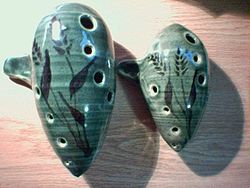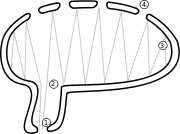- Ocarina
-
This article is about the musical instrument. For the company, see Ocarina Networks.
Ocarina 
Classification Wind, Woodwind, Aerophone Related instruments Xun, Tin Whistle, Recorder, Flute The ocarina (/ɒkəˈriːnə/) is an ancient flute-like wind instrument.[1] Variations do exist, but a typical ocarina is an enclosed space with four to twelve finger holes and a mouthpiece that projects from the body. It is often ceramic, but other materials may also be used, such as plastic, wood, glass, clay, and metal.
Contents
History
The ocarina belongs to a very old family of instruments, believed to date back to over 12,000 years.[2] Ocarina-type instruments have been of particular importance in Chinese and Mesoamerican cultures. For the Chinese, the instrument played an important role in their long history of song and dance. The ocarina has similar features to the Xun (塤), another important Chinese instrument (but is different in that Ocarina uses an internal duct, whereas Xun is blown across the outer edge.)[3] In Japan, the traditional ocarina is known as the tsuchibue (kanji: 土笛; literally "earthen flute"). Different expeditions to Mesoamerica, including the one conducted by Cortés, resulted in the introduction of the ocarina to the courts of Europe. Both the Mayans and Aztecs had produced versions of the ocarina, but it was the Aztecs who brought the song and dance to Europe that accompanied the ocarina. The ocarina went on to become popular in European communities as a toy instrument.[4][5]
Its earliest use in Europe dates back to the 19th century in Budrio, a town near Bologna, Italy, where Giuseppe Donati transformed the ocarina from a toy, which only played a few notes, into a more comprehensive instrument (known as the first "classical" ocarinas). The word ocarina in the Bolognese dialect means "little goose." The earlier form was known in Europe as a gemshorn, which was made from animal horns of the chamois (Dutch: gems).
The ocarina was featured in the Nintendo video game The Legend of Zelda: Ocarina of Time, attracting a marked increase in interest and a dramatic rise in sales.[6][7]
Musical performance
Tone production/acoustics
How an ocarina works:
- Air enters through the windway
- Air strikes the labium, producing sound
- Air vibrates throughout the inside of the ocarina
- Covering and uncovering holes lowers and raises the pitch
The ocarina, unlike other vessel flutes, has the unusual quality of not relying on the pipe length to produce a particular tone. Instead the tone is dependent on the ratio of the total surface area of opened holes to the total cubic volume enclosed by the instrument. This means that, unlike a flute or recorder, sound is created by resonance of the entire cavity and the placement of the holes on an ocarina is largely irrelevant – their size is the most important factor. Instruments that have toneholes close to the voicing/embouchure should be avoided, however, because this weakens tonal production since an ocarina is a Helmholtz resonator.
The resonator in the ocarina can create overtones, but because of the common "egg" shape, these overtones are many octaves above the keynote scale.[8] In similar Helmholtz resonator instruments with a narrow cone shape, like the Gemshorn or Tonette, some partial overtones are available. The technique of overblowing to get a range of higher pitched notes is possible with the ocarina but not widely used because the resulting note is not "clean" enough, so the range of pitches available is limited to a 12th. Some Ocarina makers increase the range by designing double- or triple-chambered ocarinas tuned 1 octave apart although some double ocarinas are not made to increase the range, but to play in harmony with the other chambers.
These double and triple ocarinas can also play chords. Different notes are produced by covering the holes, and by opening and closing more or less of the total hole area. The tone is then produced through the sound hole/embouchure. The tone can also be varied by changing blowing strength to bend pitch.
Musical notation/tabulature
Ocarina music is written in three main ways. The most apparent is the use of sheet music. There are archives of sheet music either specifically written for ocarinas, or adapted from piano sheet music. Since some ocarinas are fully chromatic and can be played in professional musical situations, including classical and folk, sheet music is an ideal notation for ocarinas.
Second is the use of numerical tablature, which expresses the musical notes as numbers. Some makers have developed their own system of numerical tablature for their ocarinas, while others follow a more universal system where numbers correspond to different notes on the scale. This method is typically used by beginners who have not learned to read sheet music.
A third method uses a pictorial tablature similar to the ocarina's finger hole pattern, with blackened holes that represent which holes to cover. The tablature represents the holes on the top of the ocarina, and, where necessary, the holes on the underside. This enables easy playing, particularly for beginners. The two most popular tabulature systems are:
- The John Taylor four-hole system (invented in 1964 by British mathematician John Taylor)
- The 10 hole sweet potato system (invented by Giuseppe Donati of Budrio Italy)
Depending on the artist, some may write a number or figure over the picture to depict how many beats to hold the note.[9]
Types
There are many different styles of ocarinas varying in shape and the number of holes.
- Transverse (Sweet potato) – This is the best known style of ocarina. It has a rounded shape and is held with two hands horizontally. Depending on the number of holes, one just needs to open one more hole than the previous in order to ascend in pitch. The two most common Transverse ocarinas are the 10-holes (originated by Giuseppe Donati in Italy) and the 12-holes.
- Pendants: There are two types:
- English Pendant – These are usually very small and very portable, and use an English fingering system (4–6 holes).
- Peruvian Pendant – Dating from the time of the Incas, used as instruments for festivals, rituals and ceremonies. They are (usually the area occupied by them) today with designs of animals or simply oval (8–9 holes).
- Inline – These are often called a "fusion" of the Pendant and the Transverse. This style is known for being very small and compact, yet there are more holes than the pendant. This allows one to ascend in pitch with the linear finger pattern rather than finger combinations
- Multi chambered ocarinas – Better known as "Double" and "Triple" ocarinas, this type exists within the three broad categories of ocarina. These ocarinas overcome the disadvantage of ocarinas of having a limited range of notes. A Transverse Double ocarina typically plays 2 octaves + 2 notes, and a Transverse Triple ocarina plays with a range about 2 octaves + 7 notes. Double ocarinas for Pendant and Inline ocarinas also exist. Double Inline ocarinas are specially designed to be able to play chords, for harmonic playing.
- Ocarinas with keys have been produced by several makers, mostly experimentally, beginning in the late 19th century. Keys and slides may be added with the intention of either expanding the instrument's range, or to enable the fingers to reach holes that are widely spaced.
Similar instruments
Other vessel flutes include the Chinese xun and African globe flutes. The xun (simplified Chinese: 埙; traditional: 塤; pinyin: xūn) is a Chinese vessel flute made of clay or ceramic. It is one of the oldest Chinese instruments. Shaped like an egg, it differs from the ocarina in being side-blown, like the Western concert flute, rather than having a recorder-like mouthpiece (a fipple or beak). Similar instruments exist in Korea (the hun) and Japan (the tsuchibue).[citation needed]
A related family of instruments is the closed-pipe family, which includes the panpipes and other instruments that produce their tone by vibrating a column of air within a stopped cylinder.[citation needed]
The old fashioned jugband jug also has similar properties.[citation needed]
The traditional German instrument Gemshorn works nearly the same way as an ocarina. The only difference is the material it's made from: the horn of the chamois, goat, or other suitable animal.[citation needed]
The borrindo is a simple hollow clay ball with three to four holes, one somewhat larger and the others smaller and of the same size.[vague] The holes are arranged in an isosceles triangular form. The borrindo is made out of soft alluvial clay available in plenty everywhere in the central Indus Valley. Being of the simplest design, it is made even by children. Some adults make fine borrindos of larger size, put pottery designs on them, and bake them. These baked borrindos with pottery designs are the later evolved forms of this musical instrument which appears to have been used in its simple unbaked form since times immemorial.[citation needed] The sound notes are produced by blowing somewhat horizontally into the larger hole. Finger tips are placed on smaller holes to regulate the notes. Its ease of play makes it popular among children and the youth.
Gallery
-
A triple chambered ocarina in the bass register.
-
A Sindhi Borrindo, a form of Ocarina produced in different sizes to give different tones.The borrindo is made out of soft alluvial clay available in plenty everywhere in the central Indus Valley.
See also
References
- ^ "History of the Ocarina". STL Ocarina. http://www.stlocarina.com/ocarina-history.html. Retrieved 2007-04-21.
- ^ "History of the Ocarina". Song Bird Ocarina. http://www.songbirdocarina.com. Retrieved 2007-04-21.
- ^ "A Brief History". Terry Riley Vessel Flutes. http://www.terryrileyvesselflutes.com/a_brief_history.htm. Retrieved 2007-04-21.
- ^ King, Sharon R. (1999-02-15). "Compressed Data; Can You Play 'Feelings' On the Ocarina?". New York Times. http://www.nytimes.com/1999/02/15/business/compressed-data-can-you-play-feelings-on-the-ocarina.html. Retrieved 7 December 2009.
- ^ "Own the Ocarina of Time". IGN. 2008-11-04. http://gear.ign.com/articles/927/927008p1.html. Retrieved 7 December 2009.
- ^ Fundamentals of Musical Acoustics. Arthur H. Benade pp.473–476
- ^ "Ocarina Fingering Charts". www.hindocarina.com. http://hindocarina.com/enjoy/fingering.shtml. Retrieved 2007-04-21.
Further reading
- Adversi, Aldo. L'ocarina di Budrio: Pubblicato in occasione del 1 centenario ed a cura del comitato per le manifestazioni budriesi. Bologna: Bongiovanni, 1963.
- Cedroni, Claudio. Il Settimino di ocarine: Storia di una tradizione italiana. Bologna: Edizioni Sonic Press, 2011. (in Italian and English)
- Hall, Barry. From Mud to Music: Making and Enjoying Ceramic Musical Instruments. Westerville, OH: American Ceramic Society, 2006. ISBN 1574981390; ISBN 1574982222.
- Molinari Pradelli, Alessandro (ed.). Il suono dell'argilla: l'ocarina di Budrio 150 anni dopo. Budrio, 2003.[Full citation needed]
External links
Categories:- Fipple flutes
- Early musical instruments
- Vessel flutes
- Italian musical instruments
- Chinese musical instruments
- Flutes
- Clay toys
- Traditional toys
Wikimedia Foundation. 2010.










